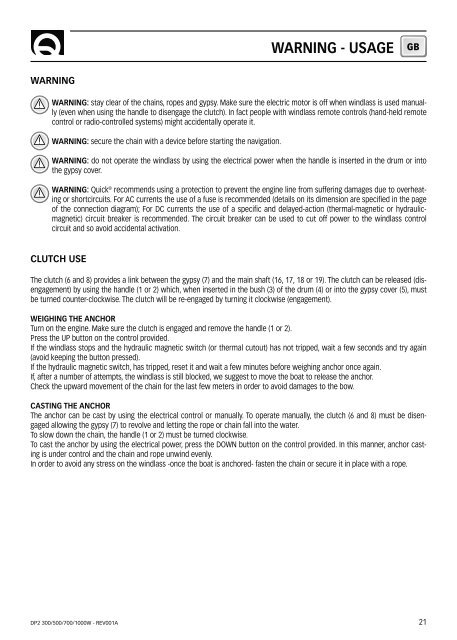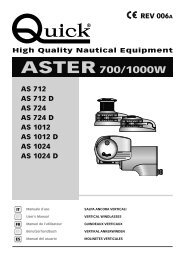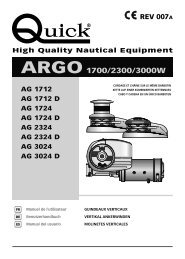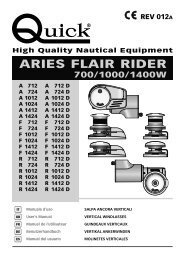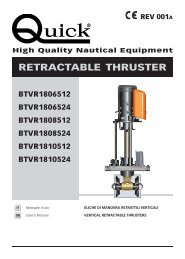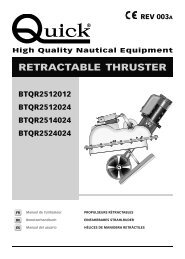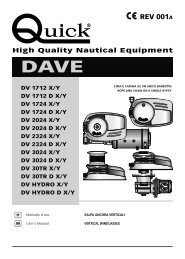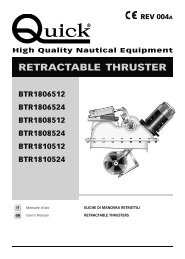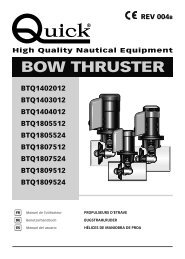DP2 SERIE PRINCE 300/500/700/1000W - Quick® SpA
DP2 SERIE PRINCE 300/500/700/1000W - Quick® SpA
DP2 SERIE PRINCE 300/500/700/1000W - Quick® SpA
Create successful ePaper yourself
Turn your PDF publications into a flip-book with our unique Google optimized e-Paper software.
WARNING - USAGEGBWARNINGWARNING: stay clear of the chains, ropes and gypsy. Make sure the electric motor is off when windlass is used manually(even when using the handle to disengage the clutch). In fact people with windlass remote controls (hand-held remotecontrol or radio-controlled systems) might accidentally operate it.WARNING: secure the chain with a device before starting the navigation.WARNING: do not operate the windlass by using the electrical power when the handle is inserted in the drum or intothe gypsy cover.WARNING: Quick ® recommends using a protection to prevent the engine line from suffering damages due to overheatingor shortcircuits. For AC currents the use of a fuse is recommended (details on its dimension are specified in the pageof the connection diagram); For DC currents the use of a specific and delayed-action (thermal-magnetic or hydraulicmagnetic)circuit breaker is recommended. The circuit breaker can be used to cut off power to the windlass controlcircuit and so avoid accidental activation.CLUTCH USEThe clutch (6 and 8) provides a link between the gypsy (7) and the main shaft (16, 17, 18 or 19). The clutch can be released (disengagement)by using the handle (1 or 2) which, when inserted in the bush (3) of the drum (4) or into the gypsy cover (5), mustbe turned counter-clockwise. The clutch will be re-engaged by turning it clockwise (engagement).WEIGHING THE ANCHORTurn on the engine. Make sure the clutch is engaged and remove the handle (1 or 2).Press the UP button on the control provided.If the windlass stops and the hydraulic magnetic switch (or thermal cutout) has not tripped, wait a few seconds and try again(avoid keeping the button pressed).If the hydraulic magnetic switch, has tripped, reset it and wait a few minutes before weighing anchor once again.If, after a number of attempts, the windlass is still blocked, we suggest to move the boat to release the anchor.Check the upward movement of the chain for the last few meters in order to avoid damages to the bow.CASTING THE ANCHORThe anchor can be cast by using the electrical control or manually. To operate manually, the clutch (6 and 8) must be disengagedallowing the gypsy (7) to revolve and letting the rope or chain fall into the water.To slow down the chain, the handle (1 or 2) must be turned clockwise.To cast the anchor by using the electrical power, press the DOWN button on the control provided. In this manner, anchor castingis under control and the chain and rope unwind evenly.In order to avoid any stress on the windlass -once the boat is anchored- fasten the chain or secure it in place with a rope.<strong>DP2</strong> <strong>300</strong>/<strong>500</strong>/<strong>700</strong>/<strong>1000W</strong> - REV001A21


